清华大学:《分子生物学》课程PPT教学课件(基因ene)第十一章 噬菌体的战略(Phage strategies)
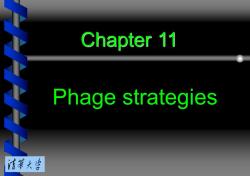
Chapter 11 Phage strategies 清革大当
Chapter 11 Phage strategies
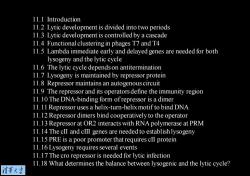
11.1 Introduction 11.2 Lytic development is divided into two periods 11.3 Lytic development is controlled by a cascade 11.4 Functional clustering in phages T7 and T4 11.5 Lambda immediate early and delayed genes are needed for both lysogeny and the lytic cycle 11.6 The lytic cycle depends on antitermination 11.7 Lysogeny is maintained by repressor protein 11.8 Repressor maintains an autogenous circuit 11.9 The repressor and its operators define the immunity region 11.10 The DNA-binding form ofrepressor is a dimer 11.11 Repressor uses a helix-turn-helix motif to bind DNA 11.12 Repressor dimers bind cooperatively to the operator 11.13 Repressor at OR2 interacts with RNA polymerase at PRM 11.14 The cIl and cIll genes are needed to establish lysogeny 11.15 PRE is a poor promoter that requires cll protein 11.16 Lysogeny requires several events 11.17The cro repressor is needed for lytic infection 11.18 What determines the balance between lysogenic and the lytic cycle? 情菜大学
11.1 Introduction 11.2 Lytic development is divided into two periods 11.3 Lytic development is controlled by a cascade 11.4 Functional clustering in phages T7 and T4 11.5 Lambda immediate early and delayed genes are needed for both lysogeny and the lytic cycle 11.6 The lytic cycle depends on antitermination 11.7 Lysogeny is maintained by repressor protein 11.8 Repressor maintains an autogenous circuit 11.9 The repressor and its operators define the immunity region 11.10 The DNA-binding form of repressor is a dimer 11.11 Repressor uses a helix-turn-helix motif to bind DNA 11.12 Repressor dimers bind cooperatively to the operator 11.13 Repressor at OR2 interacts with RNA polymerase at PRM 11.14 The cII and cIII genes are needed to establish lysogeny 11.15 PRE is a poor promoter that requires cII protein 11.16 Lysogeny requires several events 11.17 The cro repressor is needed for lytic infection 11.18 What determines the balance between lysogenic and the lytic cycle?
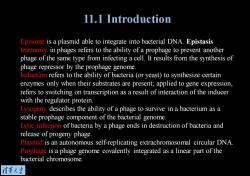
11.1 Introduction Episome is a plasmid able to integrate into bacterial DNA.Epistasis Immunity in phages refers to the ability of a prophage to prevent another phage of the same type from infecting a cell.It results from the synthesis of phage repressor by the prophage genome. Induction refers to the ability of bacteria (or yeast)to synthesize certain enzymes only when their substrates are present;applied to gene expression, refers to switching on transcription as a result of interaction of the inducer with the regulator protein. Lysogeny describes the ability of a phage to survive in a bacterium as a stable prophage component of the bacterial genome. Lytic infection of bacteria by a phage ends in destruction of bacteria and release of progeny phage. Plasmid is an autonomous self-replicating extrachromosomal circular DNA Prophage is a phage genome covalently integrated as a linear part of the bacterial chromosome 清菜大当
Episome is a plasmid able to integrate into bacterial DNA. Epistasis Immunity in phages refers to the ability of a prophage to prevent another phage of the same type from infecting a cell. It results from the synthesis of phage repressor by the prophage genome. Induction refers to the ability of bacteria (or yeast) to synthesize certain enzymes only when their substrates are present; applied to gene expression, refers to switching on transcription as a result of interaction of the inducer with the regulator protein. Lysogeny describes the ability of a phage to survive in a bacterium as a stable prophage component of the bacterial genome. Lytic infection of bacteria by a phage ends in destruction of bacteria and release of progeny phage. Plasmid is an autonomous self-replicating extrachromosomal circular DNA. Prophage is a phage genome covalently integrated as a linear part of the bacterial chromosome. 11.1 Introduction
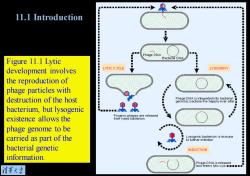
11.1 Introduction Figure 11.1 Lytic development involves LYTIC CYCLE 江” LYSOGEN¥ the reproduction of phage particles with destruction of the host cn ve hpye Phage DNA is integrated into bacterial bacterium,but lysogenic ■■■■■■ existence allows the 6R%838,品released phage genome to be carried as part of the Lysogenic bacterium is im mune to further in fection bacterial genetic INDUCTION information. 清菜大当
Figure 11.1 Lytic development involves the reproduction of phage particles with destruction of the host bacterium, but lysogenic existence allows the phage genome to be carried as part of the bacterial genetic information. 11.1 Introduction
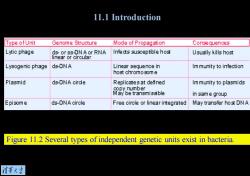
11.1 Introduction Type ofUnit Genome Structure Mode of Propagation Consequences Lytic phage ds or ss-DNA or RNA Infe ats susceptible host Usually kills hos式 linear or circular Lysogenic phage ds-DNA Linear sequence in Im munity to infection host chromosome Plasmid ds-DNA cirde Replicates at defined Im munity to plasmids oopy number May be transmissible in sam e group Episome ds-DNA circle Free circle or linear integrated May transfer ho式DNA Figure 11.2 Several types of independent genetic units exist in bacteria. 清菜大兰
Figure 11.2 Several types of independent genetic units exist in bacteria. 11.1 Introduction
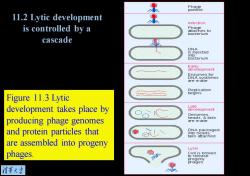
11.2 Lytic development Infection is controlled by a Phage cascade DNA eveiopment ONA Syntnesis are made B酬cation Figure 11.3 Lytic development takes place by Late development producing phage genomes and protein particles that DNA packaged into heads; tails attached are assembled into progeny Lysis phages. erele asoken progery phages 情菜大当
Figure 11.3 Lytic development takes place by producing phage genomes and protein particles that are assembled into progeny phages. 11.2 Lytic development is controlled by a cascade
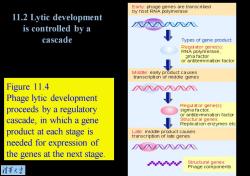
Early:phage genes are transcribed by host RNA polymerase 11.2 Lytic development is controlled by a cascade Types of gene product Requlator gene(s): RNA polymerase, gma factor or antitemmination factor Middle:early product causes transcription of middle genes Figure 11.4 入入入N Phage lytic development Regul at or gene(s): proceeds by a regulatory sigm a fa ctor, or antite mination factor cascade,in which a gene Structural genes Replication enzymes etc product at each stage is Late:middle product causes transcription of late genes needed for expression of 八风入八八 the genes at the next stage. Structural genes: 清第大当 Phage components
Figure 11.4 Phage lytic development proceeds by a regulatory cascade, in which a gene product at each stage is needed for expression of the genes at the next stage. 11.2 Lytic development is controlled by a cascade
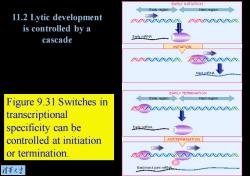
EARLY INITIATION Early region Next region 11.2 Lytic development 入入NNNN is controlled by a Early mRNA cascade INITIATION 八八八0Z02020 八入入入八NN Next mRNA EARLY TERMINATION Figure 9.31 Switches in Early region Next region transcriptional specificity can be Eark mRNA controlled at initiation ANTITERMINATION or termination. 入八NN入八八八入八N 情華大当 Early/next joint mRNA
Figure 9.31 Switches in transcriptional specificity can be controlled at initiation or termination. 11.2 Lytic development is controlled by a cascade
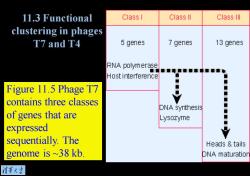
11.3 Functional Class I Class lI Class Ill clustering in phages T7 and T4 5 genes 7 genes 13 genes RNA polymerase ■■■■■■ Host interference Figure 11.5 Phage T7 contains three classes DNA synthesis of genes that are Lysozyme expressed sequentially.The Heads tails genome is ~38 kb DNA maturatior 清第大当
Figure 11.5 Phage T7 contains three classes of genes that are expressed sequentially. The genome is ~38 kb. 11.3 Functional clustering in phages T7 and T4
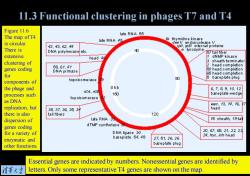
11.3 Functional clustering in phages T7 and T4 Figure 11.6 late RNA 55 The map ofT4 late RNA 45 tthymidine kinase is circular. de7V endonuclease V 42,43.62,44 io//,ip internal proteins There is DNA polymerase ete. 40 lys ozyme 57 tail fiber extensive head 40 dNMP kinase clustering of 3 sheath terminato 2 head completion genes coding 朗se 50 head completion for 65 head completion 80 5 baseplate plug components of topoisomerase the phage and Okb 6.7.89.10.12 A.日 processes such 160 b aseplate wvedge topoisomerase as DNA ac.13.19.1伦.7 replication,but 3837,363534 head there is also tail fibers 120 dispersion of late RNA 33 格sheath.19tal dTMP synthetase 2 genes coding for a variety of DNA ligase 30 baseplate 54.48 裂0mm0好2斗 enzymatic and 27.51.2626 baseplate plug other functions Essential genes are indicated by numbers.Nonessential genes are identified by letters.Only some representative T4 genes are shown on the map
Essential genes are indicated by numbers. Nonessential genes are identified by letters. Only some representative T4 genes are shown on the map. 11.3 Functional clustering in phages T7 and T4 Figure 11.6 The map of T4 is circular. There is extensive clustering of genes coding for components of the phage and processes such as DNA replication, but there is also dispersion of genes coding for a variety of enzymatic and other functions
按次数下载不扣除下载券;
注册用户24小时内重复下载只扣除一次;
顺序:VIP每日次数-->可用次数-->下载券;
- 清华大学:《分子生物学》课程PPT教学课件(基因ene)第十章 操纵子(The operon).ppt
- 清华大学:《分子生物学》课程PPT教学课件(基因ene)第九章 转录(Transcription).ppt
- 清华大学:《分子生物学》课程PPT教学课件(基因ene)第八章 蛋白质定位(Protein localization).ppt
- 清华大学:《分子生物学》课程PPT教学课件(基因ene)第七章 遗传密码的利用(Using the genetic code).ppt
- 清华大学:《分子生物学》课程PPT教学课件(基因ene)第六章 蛋白质合成(Protein synthesis).ppt
- 清华大学:《分子生物学》课程PPT教学课件(基因ene)第五章 信使RNA(Messenger RNA).ppt
- 清华大学:《分子生物学》课程PPT教学课件(基因ene)第四章 簇和重复(Clusters and repeats).ppt
- 清华大学:《分子生物学》课程PPT教学课件(基因ene)第三章 有多少基因(How many genes are there).ppt
- 清华大学:《分子生物学》课程PPT教学课件(基因ene)第二章 从基因到基因组(From Genes to Genomes).ppt
- 清华大学:《分子生物学》课程PPT教学课件(基因ene)第一章 基因是DNA(Genes are DNA).ppt
- 清华大学:《分子生物学》课程PPT教学课件(基因ene)绪论 Molecular Biology(主讲:王钊).ppt
- 河北农业大学:《分子生物学》课程教学资源(PPT课件)第十二章 免疫多样性产生的机制.ppt
- 河北农业大学:《分子生物学》课程教学资源(PPT课件)第十一章 病毒的分子生物学.ppt
- 河北农业大学:《分子生物学》课程教学资源(PPT课件)第十章 遗传重组.ppt
- 河北农业大学:《分子生物学》课程教学资源(PPT课件)第九章 真核生物基因表达调控.ppt
- 河北农业大学:《分子生物学》课程教学资源(PPT课件)第八章 原核生物基因表达调控.ppt
- 河北农业大学:《分子生物学》课程教学资源(PPT课件)第七章 蛋白质翻译(Protein Translation).ppt
- 河北农业大学:《分子生物学》课程教学资源(PPT课件)第六章 RNA转录(RNA transcription).ppt
- 河北农业大学:《分子生物学》课程教学资源(PPT课件)第五章 DNA损伤、修复和突变.ppt
- 河北农业大学:《分子生物学》课程教学资源(PPT课件)第四章 DNA复制(DNA Replication).ppt
- 清华大学:《分子生物学》课程PPT教学课件(基因ene)第十二章 复制子(The replicon).ppt
- 清华大学:《分子生物学》课程PPT教学课件(基因ene)第十三章 DNA复制(DNA replication).ppt
- 清华大学:《分子生物学》课程PPT教学课件(基因ene)第十四章 重组和修复(Recombination and repair).ppt
- 清华大学:《分子生物学》课程PPT教学课件(基因ene)第十五章 转座子(Transposons).ppt
- 清华大学:《分子生物学》课程PPT教学课件(基因ene)第十六章 逆转录病毒和逆转座子(Retroviruses and retroposons).ppt
- 清华大学:《分子生物学》课程PPT教学课件(基因ene)第十七章 DNA的重新排列(Rearrangement of DNA).ppt
- 清华大学:《分子生物学》课程PPT教学课件(基因ene)第十八章 染色体(Chromosomes).ppt
- 清华大学:《分子生物学》课程PPT教学课件(基因ene)第十九章 核小体(Nucleosomes).ppt
- 清华大学:《分子生物学》课程PPT教学课件(基因ene)第二十章 转录的起始(Initiation of transcription).ppt
- 清华大学:《分子生物学》课程PPT教学课件(基因ene)第二十一章 转录的调控(Regulation of Transcription).ppt
- 清华大学:《分子生物学》课程PPT教学课件(基因ene)第二十二章 核的剪切(Nuclear splicing).ppt
- 清华大学:《分子生物学》课程PPT教学课件(基因ene)第二十三章 催化RNA(Catalytic RNA).ppt
- 清华大学:《分子生物学》课程PPT教学课件(基因ene)第二十四章 免疫多样性(Immune diversity).ppt
- 清华大学:《分子生物学》课程PPT教学课件(基因ene)第二十五章 蛋白质间的开放交通(Protein trafficking).ppt
- 清华大学:《分子生物学》课程PPT教学课件(基因ene)第二十六章 信号的传输(Signal transduction).ppt
- 清华大学:《分子生物学》课程PPT教学课件(基因ene)第二十七章 细胞循环和生长调控(Cell cycle and growth regulation).ppt
- 清华大学:《分子生物学》课程PPT教学课件(基因ene)第二十八章 致癌基因和癌症(Oncogenes and cancer).ppt
- 清华大学:《分子生物学》课程PPT教学课件(基因ene)第二十九章 梯度、级联和发信号的途径(Gradients, cascades, and signaling pathways).ppt
- 四川大学:《植物生物学》课程教学资源(教案讲义)第一章 植物的细胞和组织.pdf
- 四川大学:《植物生物学》课程教学资源(教案讲义)第二章 植物体的形态结构和发育.pdf
